Matador Network's Blog, page 1107
May 2, 2019
Best drive-in theaters in the US

A product of the automobile-centric culture of the United States, drive-in theaters are classic Americana fodder. In the 1950s and ‘60s, drive-in theaters were all the rage, but they eventually went out of fashion as people downsized their cars and landowners sold off their acres. Plus, when the VCR was invented in the 1970s, it became easier to just watch a movie at home in your living room.
Though drive-in theaters are far less prevalent now, there are still some holdouts across the country. Check out the coolest drive-in theaters in the US that will make you forget all about your plans to lounge around and binge-watch a mindless TV series from the tiny screen of your laptop.
1. Stars & Stripes Drive-In Theatre, Lubbock, TX

Photo: Stars & Stripes Drive-In Theatre/Facebook
One of the coolest aspects of the Stars & Stripes Drive-In Theatre in Lubbock, Texas, is the ‘50s-style cafe on site. Moviegoers can enjoy Coke ICEEs, burgers, funnel cakes, and fries as if they were hopping over to the local soda shop for “rockin eats and tasty treats,” as the theater puts it. Plus, kids will want to go early to enjoy the theater’s playground and swing set. The Stars & Stripes Drive-In has three screens and is open year-round.
2. Fiesta Drive-In Theatre, Carlsbad, NM
A family-owned and -operated business for nearly three decades, Carlsbad’s Fiesta Drive-In Theatre is one of the only drive-ins open year-round. There’s a concession stand on site with “award-winning” popcorn, pizza, fries, chili, hot dogs, burgers, candy, and drinks. Best of all, it’s easy for locals to make the Fiesta Drive-In part of their regular routine, just like the good old days: Membership to the Fiesta Drive-In Club costs just $10 per month and grants you 50 percent off all your ticket purchases.
3. Skyview Drive-In, Belleville, IL

Photo: PhilipR/Shutterstock
Open on weekends from April to October, the Skyview Drive-In in southern Illinois dates all the way back to the golden age of drive-in movie theaters (and has a website straight out of the ‘90s to prove its commitment to vintage). Opened in 1949, the screen was destroyed by a tornado in the mid-1950s and then rebuilt. If you’re choosy about your view, you can even reserve a prime spot for your car in advance. An antique neon sign welcomes moviegoers and the nostalgic for a night with the silver screen.
4. Swap Shop Drive-In, Fort Lauderdale, FL
The Swap Shop Drive-In in Fort Lauderdale, Florida, does double duty as a flea market and drive-in theater. The swap shop is open 365 days a year, rain or shine, and movies play nightly at 8:30 PM. For vendors who want to clean out their garages, make some money, and catch first-run movie at a bargain price, all in the same day, the Swap Shop Drive-In is the place to be. No vendor reservations are required; you can simply show up, pay at the gate, and hope to drive home with padded pockets.
5. Starlite Drive-In Movie Theater, Litchfield, MN
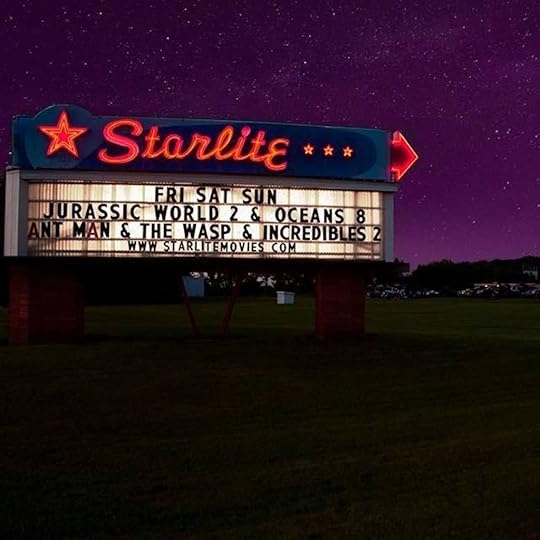
Photo: Starlite Drive-In Litchfield Mn/Facebook
Starlite Drive-In Movie Theater has been a Litchfield, Minnesota, institution for over 100 years — the classic small-town setup opened in 1914. Your ticket grants you access to a double feature, and the original old-style branding makes it feel like you’re being transported back in time. The Starlite Drive-In is open only on spring and summer weekends.
6. South Bay Drive In, Imperial Beach, CA
Each of the three screens at the South Bay Drive In in Imperial Beach, California, shows a double feature, so you can be sure you’re getting your nine-dollars worth (tickets are only a dollar for kids aged five to nine). Open 365 days a year, the South Bay Drive In is located just three miles from the beach and is a popular activity in southern California for locals and tourists alike. The drive-in also hosts a weekly swap meet with over 300 vendors, and admission only costs 50 cents to a dollar depending on which day you decide to go.
7. Starlight Drive-In Theatre, Atlanta, GA
The unique Art Deco style of Atlanta’s Starlight Drive-In Theatre is only part of the theater’s appeal: There’s also the fact that it plays a wide variety of the latest hit movies rather than just a small selection. It also has a flea market during the day and a snack bar where movie patrons can stock up on movie treats. Located on the outskirts of the city, the theater now has four screens (after starting off with just one) and is one of the few theaters to not just survive but thrive ever since its debut in the late 1940s.
8. 66 Drive-In, Carthage, MO

Photo: Steve Lagreca/Shutterstock
If you’re going for a classic American road trip along Route 66, the 66 Drive-In in Carthage, Missouri, is a perfect addition to your itinerary. Illuminated with a retro neon sign and giant billboard to catch the eyes of passing motorists, the 66 Drive-In also has a concession stand with a large menu of classic American eats, including hot dogs, BBQ sandwiches, nachos, candy, and more. A “nostalgic intermission trailer” is played during the break between the double features to add to the throwback vibes of the experience.
9. Malco Summer Quartet Drive In, Memphis, TN
The Malco Summer Quartet Drive In is part of the Malco chain of movie theaters, which has been family-owned and -operated for over 100 years. Open only on weekends, the retro-style drive-in in Memphis offers free admission to kids under 10. In addition, it functions as a venue for other forms of entertainment like operas, concerts, and live performances all year long.
10. Bengies, Baltimore, MD
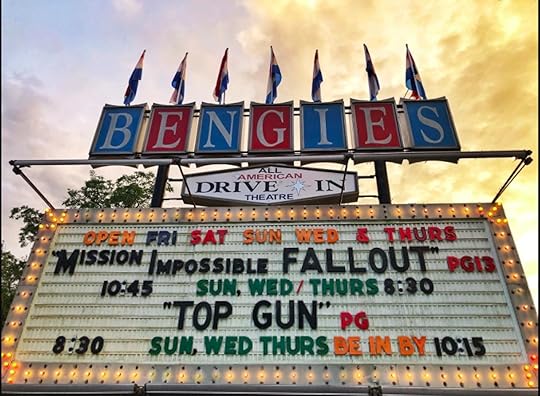
Photo: Bengies
Opened in 1956, Bengies in Baltimore claims to have the biggest movie theater screen in the USA. In true American pride, every show opens with the national anthem. This drive-in is one of the only theaters to screen a triple feature, offered on most Friday and Saturday nights. In between movies, guests are entertained by old intermission clips, classic cartoons, and vintage trailers, not to mention the snack bar and large playground. On Memorial Day and Labor Day weekends, Bengies offers all-night shows from dusk to dawn. The Bengies season stretches from early spring to late fall, and it even rents electric in-car heaters for one dollar if you’re worried about getting too cold.
11. Silver Moon Drive-In Theatre, Lakeland, FL
The Silver Moon Drive-In Theatre in central Florida has a 70-year history, and it’s still going strong. There’s a snack bar with pizza, corn dogs, “chilly dilly pickles,” beers, breakfast sandwiches, and more. Both of the Silver Moon’s two screens show a first-run double feature seven nights a week, which you can listen to via your FM car radio or in-car speakers.
12. Harvest Moon Twin Drive-In Movie Theatre, Gibson City, IL
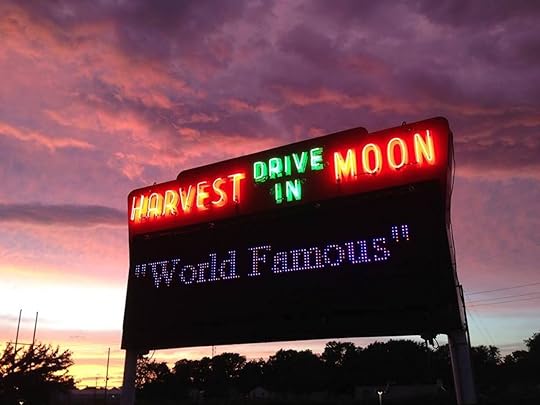
Photo: Harvest Moon Twin Drive-in Theatre/Facebook
The Harvest Moon Twin Drive-In Movie Theatre not only screens hit movies rain or shine, they also put on special event programming to keep visitors entertained in new ways, such as superhero costume contests, luau parties, a fall FrightFest with horror movies, and more. However, perhaps the most unique part of the Harvest Moon Drive-In is the fact that moviegoers can grill their own food while catching a show (but there’s a five-dollar food permit per car to bring outside food or drink).
13. Fairlee Motel and Drive-In Theater, Fairlee, VT
The only thing better than heading to a drive-in movie for the night is staying the night at the movies, which Vermont’s Fairlee Motel and Drive-In Theater gives you the chance to do. One of only two motel/drive-in combinations left in the entire country (and the oldest), the Fairlee is a simple, one-story motel where you park in front of your room and get charged by the person and by the bed. You can watch the movie from your car or motel room — the rooms have rear windows with views of the Fairlee Drive-In Theater. Stop by the drive-up snack bar to stock up on hot meals and popcorn with real butter.
14. Coyote Drive-In, Leeds, AL

Photo: Coyote Drive-In Alabama/Facebook
Nothing is more quintessential American than a menu of burgers and hot dogs at the drive-in theater in a small Southern town. For a Friday night straight out of the ‘50s, head to Leeds, Alabama, and hit up Coyote Drive-In. Part of the Coyote Drive-In’s enduring appeal is the fact that you can have an experience just like “the good old days” and enjoy gathering around the latest hit movie with family and friends. The Coyote Drive-In is only open during spring and summer.
15. Wellfleet Drive-In Theater, Wellfleet, MA
An alternative to the usual Cape Cod attractions, the Wellfleet Drive-In Theater in Massachusetts has not just movies but also a mini-golf course, retro snack shop, bar and grill, and a flea market with up to 200 vendors. It’s the ideal one-stop shop for families who want to eat, shop, play, and enjoy some good old-fashioned wholesome entertainment. The drive-in portion is open “from Memorial Day through a little after Labor Day” while the traditional indoor cinema is open year-round. 

More like this: 7 iconic cars from around the world and the stories behind their popularity
The post The 15 coolest drive-in theaters in the US appeared first on Matador Network.

Cruise quarantined due to measles
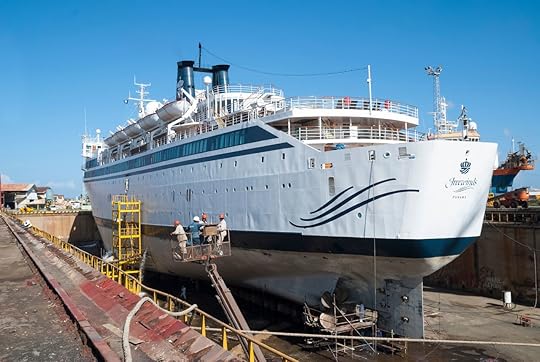
The cruise ship Freewinds has been placed under quarantine by the island of St. Lucia after a case of measles was reported on board. Dr. Merlene Fredericks-James, the island’s chief medical officer, made the decision to prevent all passengers and crew from disembarking after a confirmed case of the highly contagious disease was reported on board.
The United States is currently in the midst of a measles outbreak. According to the Center for Disease Control and Prevention, “from January 1 to April 26, 2019, 704 individual cases of measles have been confirmed in 22 states. This is the greatest number of cases reported in the US since 1994 and since measles was declared eliminated in 2000.”
The boat, supposedly owned by the Church of Scientology, is believed to have about 300 passengers on board, though the ship’s doctor confirmed that the measles case has been isolated on the ship.
According to the BBC, although St. Lucian authorities can prevent anyone from disembarking, they cannot, however, keep the ship in port indefinitely. It is scheduled to leave the island around midnight on Thursday.
Recently, many measles cases have been linked to unvaccinated international travelers, especially air travelers. Last month, a flight attendant for Israel’s El Al airline became ill with the measles and was in a coma.
Measles is a very serious virus that can be lethal or lead to very severe and long-term complications, especially in children. 
H/T: BBC

More like this: These are the travel vaccines you actually need, according to an expedition doctor
The post Cruise ship quarantined in St. Lucia after measles case appeared first on Matador Network.

Man fails breathalyzer eating durian

Durian is infamous for being the stinkiest fruit in the world, but apparently, it can also make you fail a breathalyser test. According to Chinese video website Pear Video, a man in Rudong county, China, was pulled over by police for suspected drunk driving and failed a breathalyzer test — but not for the reasons the cops suspected. “I’ve just been eating durian fruit,” he told them. A subsequent blood test showed that there was no alcohol in the man’s system, clearing the man of any wrongdoing but positioning the fruit for a whole lot of blame.

Photo: Pear Video
To better understand the phenomenon, police carried out tests on themselves to determine how ingesting the fruit affected breathalyzer results. The officer involved in the test saw his blood alcohol level rise to 36mg per 100ml when the legal limit is only 20mg per 100ml in China. The officer was retested three minutes later with a negative result, showing that perhaps the fruit causes blood alcohol levels to spike before subsiding.
While some commenters urged the police to apologize to the man interrogated for drunk driving, others were more concerned about how the driver could possibly tolerate eating durian in a confined space given its infamous odor. 
H/T: BBC

More like this: The 9 weirdest fruits in the world and where to try them
The post Man fails breathalyser test after eating too much durian appeared first on Matador Network.

How to date a Wisconsinite

You’ve landed yourself a date with a Wisconsinite — lucky you! People from Wisconsin are some of the kindest you’ll ever meet, thanks to our “Midwest nice” culture. However, there are some things we just can’t tolerate on a first (or even 50th) date. Here are nine things you should never say on a first date with a Wisconsinite.
1. “How ’bout dem Bears?”
Do you mean that they don’t have anything on the greatness of the Packers? Or were you trying to say something else, like that you like them? If that’s the case, I’ll just go ahead and ask for the check, because this date is over.
2. “I’m vegan.”
You didn’t tell me this before I took us to the best burger place in town and ordered fried cheese curds. If we can’t enjoy meat together (it’s all I have in my freezer, after all) or not even cheese, then things just aren’t going to work out between us.
3. “I only drink wine.”
If you don’t drink beer or brandy, how are we supposed to go on brewery tours and eventually have our wedding at my favorite one?
4. “What’s a cheese curd?”
My relationship with cheese curds is too advanced for me to slow down and explain it to you.
5. “I would never live in Wisconsin.”
Excuse me while I choke on my Spotted Cow. Like any true Wisconsinite, I require more than mere love to pull me away from the state I call home. If you can’t imagine yourself living in Wisconsin, this relationship is already over.
6. “Shouldn’t you have dressed up?”
My jeans and a plaid button-down is dressed up. It’s not my fault you’re dressed to the nines. I thought we were getting drunk on beer and full on cheese, not going to the opera.
7. “Are you going to finish that?”
You betcha I am. I always finish my plate like the good Wisconsinite I am. Now get your hands off my burger.
8. “Want to come in for a drink? I have Bud Light in the fridge.”
No thanks, I’d literally rather go home and read a book than drink a non-Wisconsin beer
with you. Next time, know your audience and stock up on the Miller Lite.
9. “Who’s Aaron Rodgers?”
What kind of question is that? Who’s Aaron Rodgers? Who are YOU? Not my significant other, that’s for sure. 

More like this: The 9 things only Wisconsinites find funny
The post 9 things you should never say to a Wisconsinite on a first date appeared first on Matador Network.

May 1, 2019
Snorkeling around Ulleungdo Island

Ulleungdo is a volcanic island 75 miles east of South Korea, a dream for any off-the-beaten-track traveler. The island has long attracted South Koreans who appreciate its dramatic volcanic cliffs and rock formations, primeval forests, and crystal clear water. Hiking is very popular, meaning some trails get congested during the peak season. The surrounding ocean, however, is often a lot emptier — making snorkeling a great way to explore parts of the island that the average tourist won’t see.
An eerie volcanic island
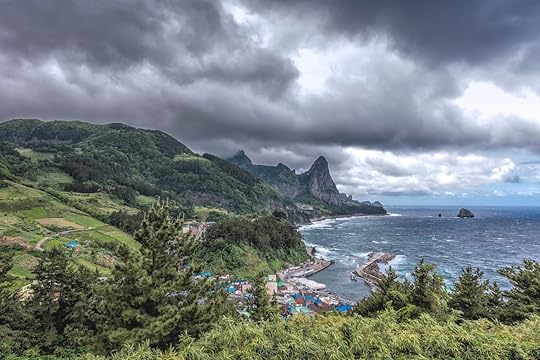
Photo: Daecheol/Shutterstock
Ulleungdo is sometimes called Korea’s mysterious island. This may have to do with its distance from the mainland or its eerie rock formations, which reflect the island’s volcanic origins. Ulleungdo is essentially the peak of a massive volcano that plunges downwards to the sea floor.
That topography, though, makes for some great snorkeling. Beaches drop off quickly to a depth of about 10 to 20 feet, and visibility is usually around 100 to 130 feet. During the summer months, the water temperature is around 75 degrees, making it a great break from the intense humidity on the island.

Photo: NAMHUN KIM/Shutterstock
Ulleungdo is well known in South Korea for its squid, and you’ll see hundreds of squid left out to dry in all the fishing towns. If you’re lucky, you’ll see the sea creatures’ translucent bodies flitting through the water while you snorkel.
Getting around Ulleungdo can be daunting to an English-speaking traveler. There is very little English spoken on the island, but you will always find someone willing to help. Here are the top places to snorkel around the island.
Hakpo beach
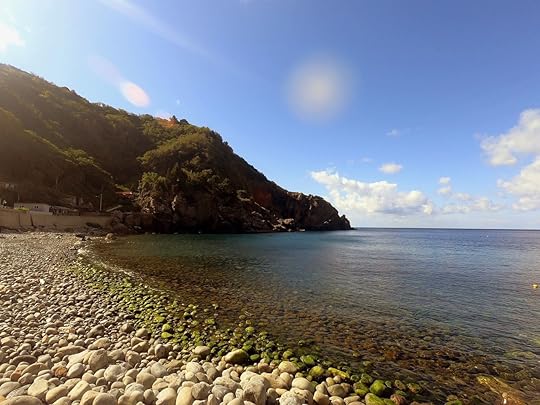
Photo: Chris Couperthwaite
Hakpo beach is part of Hakpo village on the west side of the island, and it’s just below one of the two main campsites on Ulleungdo. Getting to the beach requires a short 20-minute walk down a steep hill from the closest bus stop. It’s the best beach on the island — in part because it’s protected by two large cliffs that jut far out into the ocean and keep the water relatively calm.
During the peak tourist season, a variety of water activities are offered, including glass-bottomed boats, banana boats, a scuba experience, and snorkeling. If you can, bring your own snorkeling gear; if you rent, you won’t get fins, and you’ll be required to wear a life-jacket.
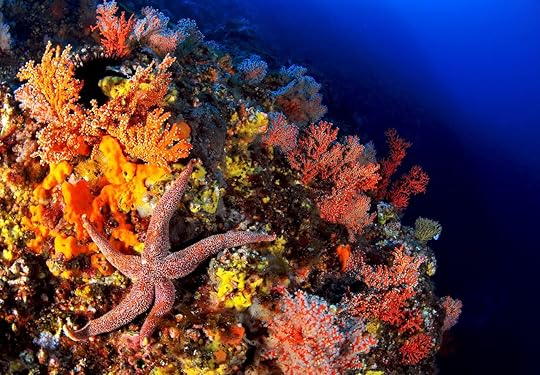
Photo: Simon Shin/Shutterstock
In spring and early summer, you will see hundreds of aplysia kurodai, members of the large sea hare or sea slug family. It may sound odd, but these animals can be fascinating to watch as you snorkel among the rocks and large patches of seaweed. Watch where you step, though, as it may be on a soft slug.
Like most beaches on Ulleungdo, Hakpo beach is rocky, so there aren’t places to just throw down a blanket and soak up the sun. There is a gazebo overlooking the beach that provides shaded seating and a small café that has tables and umbrellas.
Naesujeon mongdol beach

Photo: Chris Couperthwaite
The Naesujeon Mongdol beach is on the east side of Ulleungdo. It’s much easier to get to than Hakpo beach; a short two-minute walk from the closest bus stop will get you there. It offers water activities during the summer months, but there is less space to swim. There are also fewer places to sit and relax while you’re not swimming.
That said, an advantage of the Naesujeon beach is that part of its swimming area walled off with large tetrapods, which are like concrete cones that shore up breakwaters. This means that, even when the ocean is rough around the rest of the island, this area is calm.
An interesting variety of marine life have made their homes in the spaces between the tetrapods, and if you look carefully, you’ll even see fluorescent patches of algae. Shoals of squid can be seen around this area, and it’s easy to spend several hours enjoying the warm water and marine life.
Tonggumi beach

Photo: Nghia Khanh/Shutterstock
Tonggumi beach is one of the few sandy beaches on Ulleungdo. It sits in the shadow of the famous Geobukbawi, Turtle Rock in English, which rises sharply from the sea. Tonggumi is one of the many great places to view the sunset on Ulleungdo.
Apart from some fishermen standing around on the rocks, you will almost always have this beach to yourself, and you can snorkel unimpeded, exploring the depths of the island. This is another place to catch a glimpse of the elusive squid while you are snorkeling.
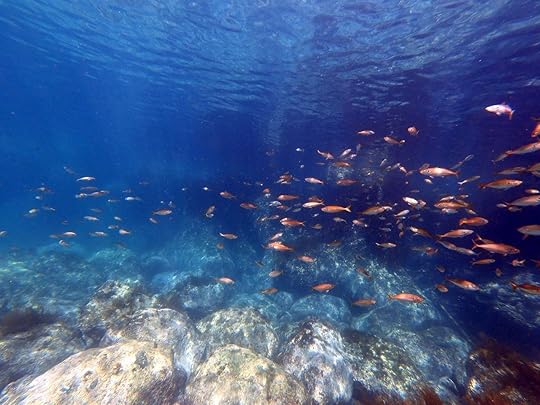
Photo: Chris Couperthwaite
Unfortunately, the water can get very rough at Tonggumi beach. It’s not uncommon to have waves breaking onto the parking area under Turtle Rock. If the sea is too rough to swim at Tonggumi, it’s easy enough to catch the next bus and head back to Hakpo beach.
Jeodong and Dodong
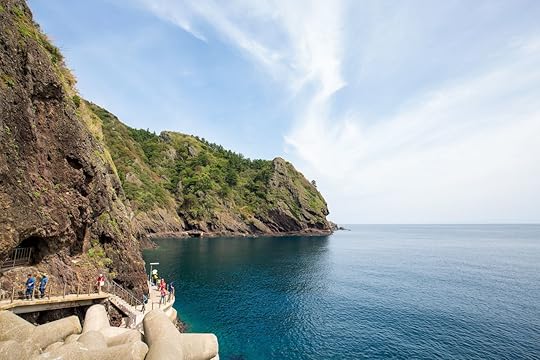
Photo: From Nghia Khanh/Shutterstock
If you’re looking for more of an adventure than just snorkeling at the designated beaches, you can jump into any piece of open ocean you find. There are no restrictions to swimming on the island. On the east side, around Jeodong and Dodong, the island drops away almost immediately to around a 100-foot depth. The rock face is pitted with crags and holes that hide fish and are waiting to be explored.
Around the Dodong sea walkway, which snakes alongside the steep mountainside, you’ll see remnants of old pathways that have sunk to the ocean floor. You can swim alongside the little coves formed by years of wear from the ocean and through fun rock formations. If you swim around the walkway you’ll have many fascinated tourists waving at you and checking if you are okay.
Getting to Ulleungdo
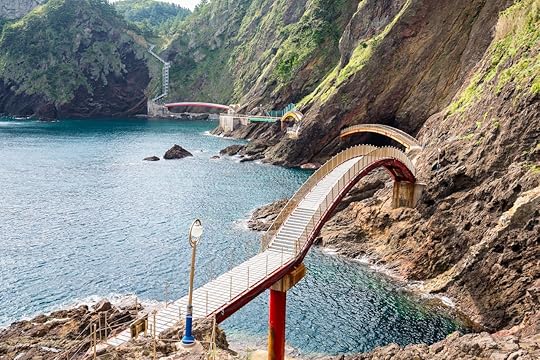
Photo: Nghia Khanh/Shutterstock
Currently, the only way to get to Ulleungdo is by a four-hour ferry ride from mainland South Korea. The ferries run from four towns — Pohang, Mukpo, Hupo, and Gangneung. During peak season it’s essential to book in advance as seats on the ferries fill up fast, and there aren’t always tickets to buy at the terminal. Booking is often only in Korean, so it may be easier to use a tour company. It takes a little extra effort, but the natural beauty of Ulleungdo, both in the water and on land, is well worth it. 

More like this: How to snorkel with the oldest living things on Earth
The post Snorkeling on South Korea’s mysterious Ulleungdo island appeared first on Matador Network.

Glamping resort Patagonia, Chile

You don’t get a whole lot of street cred for glamping.
Tell your friends you’re going on a mission to Patagonia, and they’ll imagine you hiking up snowy boulders and sleeping in flimsy tents on a mountainside. Real character-building stuff. Post pictures sipping Champagne in a jacuzzi that same night, and now you’re a bougie tourist.
But really, who cares? Because when you can enjoy some of the most spectacular wilderness in the world from the warmth of a finely appointed yurt, street cred doesn’t seem so important.
This is what you’ll experience at the Patagonia Camp, ensconced deep in Chile’s Torres Del Paine National Park, along the shores of Lake Toro. It’s every bit the Patagonia you’ve imagined, with bright turquoise water lapping up against deep green Nothofagus trees and snow-capped mountains in the distance. But it is also the epitome of luxury.
For about $400-$500 a night, depending on how long you stay, you’ll get an all-inclusive experience, full of daylong hikes, fine wines, great food, and plush surroundings. You’ll also get the opportunity to go on themed retreats, with everything from yoga to photography dominating your itinerary. But most of all, you’ll get a chance to experience one of the great travel destinations on the planet, without having to “rough it” at all.
The luxury begins when the wheels touch the ground.

Photo: Laura Grier
After a private transfer collects you at Punta Arenas airport in far-southern Chile, you ride about four to five hours into the mountains, past glaciers, lakes, rivers, and a whole lot of sheep. You arrive at the front gate, greeted by smiling, waving, fleece-wearing staff who speak both English and Spanish.
They lead you into the beautifully bright main lodge, where a wall of windows looking out on the turquoise lake and a dining room set for about 40 guests greets you. The Andean sunshine creates a natural glow off the wooden interior, and a host seats you on a plush couch while bringing you a glass of wine.
The wine is exquisite, the product of Matetic Vineyard, owned by the same people who own the camp. The Malbec is the obvious choice given where you are in the world, but the Syrah is the superstar.
After checking in and enjoying a bowl of warm nuts, you are led down a concrete path as the cool mountain air blows through your face. You arrive at a large, white yurt with a hot tub in front of it. This is home for the next few days. And while yurts traditionally have been fierce structures designed to withstand the winds of the Mongolian steppes, they’ve never been what one might describe as “posh.” Your home, however, is different.
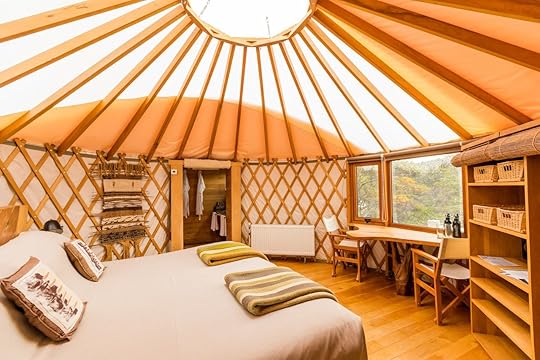
Photo: Laura Grier

Photo: Laura Grier
Inside you find hardwood floors and a comforting wave of heat. The twin beds set into wood frames on each side of the room are covered in wool blankets, with mattresses that feel like you’re sinking into a slightly scratchy heaven.
Across a shared bathroom — complete with stone showers and heated towel racks — sits another bedroom with a panoramic view of the lake. This is a family yurt, as the camp calls it, designed for parents and kids to have different rooms. But they also have single-bedroom suites and a honeymoon suite. The host tells you to be back in the meeting room at 6:30 PM for a brief on the next day’s excursions.
Setting off into the wild — kind of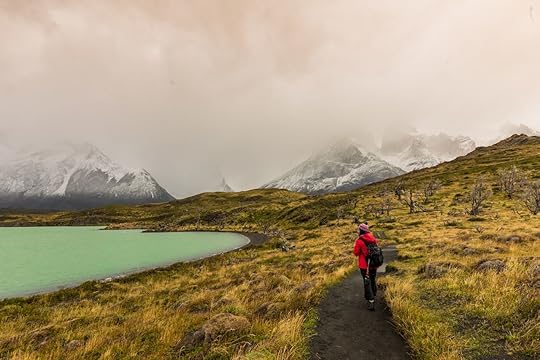
Photo: Laura Grier
In Patagonia, weather can change instantly, so even though guides have a pretty good idea of what you can do the next day, everything is weather dependent. Today, the guide is offering a drive to view wildlife in the eastern part of the park, a five-mile hike to a lake, or an all-day trek to the famous Mirador de las Torres. You didn’t come to Patagonia to sit in a car and look at animals, so of course you opt for the longest hike of the day.
The view at Mirador de las Torres (view of the towers) is one of the most iconic in all of Patagonia, a remote glacial lake that butts up against the region’s most noticeable mountains. It’s also not easily obtained, as the 15-ish-mile trail is the final part of Patagonia’s famous W, ranging through steep hills, thick forests, and blustery snowy peaks.

Photo: Laura Grier
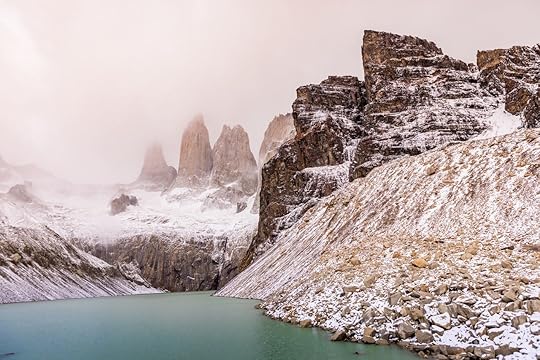
Photo: Laura Grier
Before you leave, your guide hands you each a gourmet sandwich — ranging from fresh-cut roast beef with pesto sauce and arugula to falafel with fresh cucumber and tahini – along with chips, fruit, and a couple of chocolate bars. On this hike, there’s no time to stop. But on shorter ventures, he sets up a full picnic lunch with soup, salad, beer, and hot chocolate, which you enjoy al fresco in the park.
The hike is long and grueling, and as you return to the parking lot after 10 hours on the mountain, your driver has a spread of charcuterie and beers waiting. After spending the final two hours of the hike talking about how good a cold beer would taste, it seems almost like the Patagonia Camp was reading your mind.
Bubbles under the stars
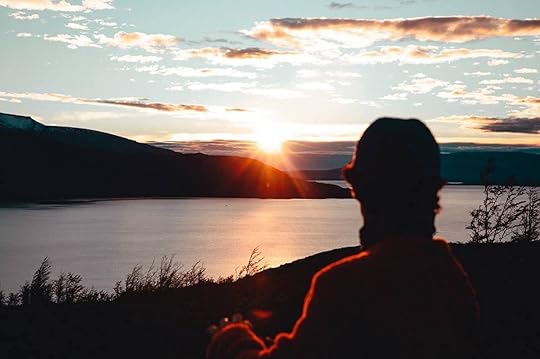
Photo: Patagonia Camp/Facebook
You return to the camp as the sun is setting, and instead of showering you instead ask the bar for a couple glasses of wine to take to your jacuzzi.
“Take a whole bottle,” the bartender says. After all, all the liquor is included. “It’ll keep you from having to come back up.”
Muscles aching, dirty, wet, and exhausted, you change into a suit and slide into the hot tub. Immediately the pain of the previous 10 hours melts away. All you’re left with are memories of the spectacular journey you had through the forest, a glass of wine, and warm bubbles. The view out over the lake isn’t bad either, as you see other guests in kayaks fishing in the water.
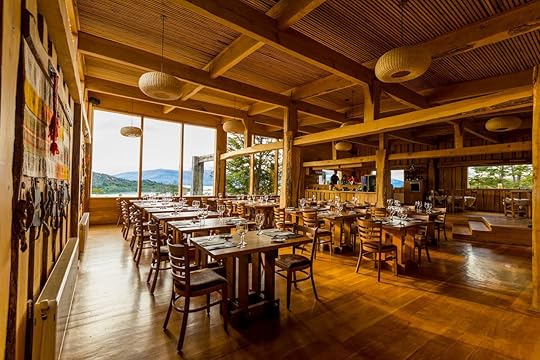
Photo: Laura Grier

Photo: Patagonia Camp Link
After a hot, high-pressured shower in your yurt, you head to the dining room where options are sirloin, fresh sea bass, and potato gnocchi. You wash your steak down with more wine and a couple of cocktails, before heading back into the night to end a perfect day in Patagonia.
Tempted by the canopy of bright stars overhead, you make one more trip into the hot tub before calling it a night. The cool air makes steam rise from the water, as you lay back and gaze at a sky totally different than the one in your hemisphere.
After you feel yourself starting to doze off, you put on the robe and slippers the camp provided and slip back into your luxury yurt, collapsing into the folds of your mattress for the best night’s sleep you’ve had in months. The mountain air and 15-mile hike will help with that. But so will wine and high-thread-count sheets.
You wake up in the morning to a full breakfast, which you take back to your yurt and enjoy as the sun rises over the lake. You snap a picture and decide to post it when you get back upstairs, where the WiFi is surprisingly good for being four hours from the nearest major airport.
Perhaps people will think you’re not as tough as they thought when they realize your Patagonia vacation was spent indulging when you weren’t in the wilderness. But for those who aren’t so big on sharing their sleeping bag with field mice and freezing at night, there is no better way to see Patagonia. 

More like this: The Valdes Peninsula is the absolute best place in Patagonia to see wildlife
The post There’s a glamping resort in Patagonia, and it just made your dream trip even dreamier appeared first on Matador Network.

Best things to do in Marche, Italy
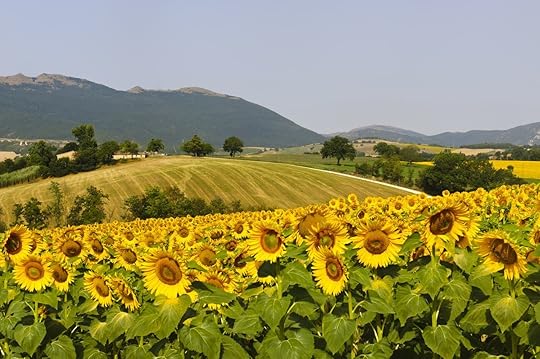
The stone piazza in Urbisaglia, in the Marche region of central Italy, is like many in the country’s medieval villages. School kids play soccer under the shadow of a 16th-century tower, their abandoned book bags strewn on the church steps. Two older men sit on a bench and talk politics. A woman crosses the piazza, heading home with groceries in-hand. The clothing store shopkeeper steps outside to smoke a cigarette as a pair of travelers watch Italian life unfold, relaxing over aperitivi and snacks on a cafe patio. The difference between here and Rome or the Amalfi Coast is that they are the only tourists around.
Shaped like a big apostrophe, Le Marche, or Marche as it’s commonly known, is northeast of Rome in a shallow curve that juts into the Adriatic Sea. The Apennine Mountains mark the west of the region, with rivers flowing from the mountains through midland hills to the sea. The northernmost river delineates the border with Emilia Romagna, the southernmost with Abruzzo. The name means “the borderlands” in Italian, and geographically defined borders have kept this region all but a secret for centuries.
Most of the few visitors the area receives mispronounce its name, which flows off the Italian tongue as “Lay Markay.” Much of the region is covered in open countryside just a 30-minute drive from both mountains and the sea, surrounded by medieval hilltop towns, patchwork fields, grapevines, olive trees, and sunflowers. On your next Italian trip, come here and stay in a B&B or rent a vacation home for a week. There’s no better place to feel like a local.
Stay in Urbisaglia and explore the region’s ancient archaeology.
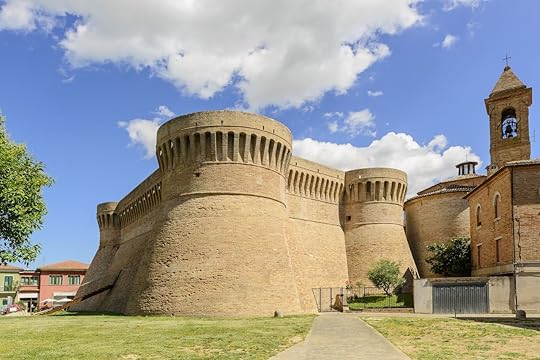
Photo: Wolfgang Zwanzger/Shutterstock
Urbisaglia is a fortified city on a hill in the Macerata province, with walls built from stones taken from the ruins of the ancient Roman settlement Urbs Salvia. Though the original settlement was destroyed by the Goths in 409 AD, the ruins are preserved in a landslide below the town in a 100-acre archeological park. A temple and the 5,000-seat amphitheater are visible as you drive by on Highway 78. Excavated statues and carvings are displayed at the Municipal Archeological Museum in Urbisaglia’s historic center. If you visit during the summer, the amphitheater hosts regular performances and plays often preceded by an outdoor dinner — a great opportunity to mingle with local residents and other visitors and get a feel for the area’s artistic chops.
Le Marche’s 112-mile long Adriatic coastline has 29 Blue Flag beaches, recognized for clean water and environmental quality. Clifftop medieval villages with postcard views overlook the sandy coast and occasional rocky inlets, and you can explore both the beaches and villages on foot. You may pass by local men playing bocce in the shady park that separates the beach from the road, but even during the height of Italy’s tourist season in July and August, there’s always a spot for your beach towel.
Take part in weekly festivals held from spring to fall.

Photo: poludziber/Shutterstock
Three earthquakes struck southwest Le Marche in 2016. San Ginesio, a walled city known as a borghi più belli, one of the most beautiful villages in Italy, suffered immense damages. Renovations are underway, but the indomitable spirit of the residents went uninterrupted. San Ginesio continues to host an annual horse race called a palio that is part of La Medievalia, among the more popular draws to the area. Held in the days leading up to the August 15 holiday, the festivities start with a battle reenactment and include jousting competitions, dances, performances, and a communal dinner in the old-town style for attendees. You’ll be served recipes dating back to the 1300s, celebrating the 1377 victory of local residents over attackers from the town of Fermo.
Also worth a visit on your Macerata visit is an elliptically shaped arena known as the Sferisterio, built in the 1820s for local circuses, bullfights, and other competitions. The arena has space for 7,000 spectators, who nowadays watch headlining musical acts perform outdoor concerts. The facility also hosts the massive Macerata Opera Festival each summer. After weekend opera shows, organizers clear space for themed parties, concerts, and dancing under the stars until the wee hours. This is among the most traditional, old-Italy experiences in which you can actually take part as a visitor.
Admire Renaissance art and architecture.

Photo: pavel068/Shutterstock
The historic city center of Urbino, a small town in the heart of La Marche, was awarded UNESCO World Heritage status for its well-preserved Renaissance character. In the 15th century, Duke Frederico da Montefeltro, a famous soldier and art patron, brought notable artists and architects to Urbino to build his Palazzo Ducale, “a city in the form of a palace.” The Ducal Palace, with its narrow twin towers, was designed to face Florence and is where you can admire artworks by notable artists such as Raphael (who was born in Urbino), Piero della Francesca, van Ghent, and Titian.
Drink award-winning wines you can actually afford to buy.

Photo: Mario Troiani/Shutterstock
Le Marche’s climate and soil are ideal for winemaking, and the region produces notable yet reasonably priced wines. The region is known for a white grape called verdicchio, the base for many a highly praised wine from the area made with the same grape. It grows in two different regions: Jesi, influenced by the sea, and Matelica, in a mountain valley. Winemakers offer free tastings and private tours, most likely given by an owner. Be sure to try a glass of both Castelli di Jesi Verdicchio Riserva DOCG and Verdicchio di Matelica Riserva DOCG and taste the difference between the two areas.
If you’re a red wine drinker, Marche has at least a few bottles with your name on it. Vernaccia di Serrapetrona is made in a 163-acre region in Serrapetrona, and the same grape makes three distinct wine styles: a dry red perfect with grilled meat, a unique dry sparkling red that is excellent with pork, and a sweet sparkling red that’s best with dessert. You can try all three at Alberto Quacquarini’s tasting room. If you call ahead, they’ll show you how it’s done in their cantina.
Explore the mysterious Sibillini Mountains.
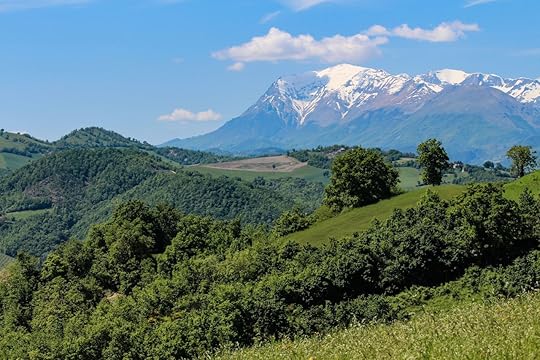
Photo: SalliAnn/Shutterstock
Travelers have sought out the Sibillini Mountains for centuries. The region’s southwestern border was long known as a land of fairies, mystics, and the eponymous prophetess Sibyl, who lived in a cave near the summit of Mount Sibilla. These same enchanting mountains now encompass the 270-square-mile Monti Sibillini National Park in which medieval villages and a network of shelters provide hospitality to hikers trekking the nine-day-long “Great Ring,” a 77-mile path that encircles the park. Be sure to pack and prepare properly if you plan to tackle part or all of this trek.
Wildflowers abound here in the summer, which is also peak time for bird watching, hiking, and biking the many trails. Winter brings skiing, sledding, and snowshoeing, after which you can warm up in one of the many restaurants serving hearty local cuisine. Guided full-moon evening hikes and stargazing events are offered year-round if you prefer to have an experienced local leading the way.
Eat and truly feel like you’re part of the family.

Photo: Osteria Scherzi A parte/Facebook
After exploring the high country, a restaurant you absolutely must try is Osteria Scherzi a Parte, a longtime local favorite near the medieval mountain town of Sarnano. The place is the perfect stop after exploring the national park, where you’ll be greeted not only by the owner Gabriele at the door but by other diners as you sit down to a meal. Gabriele may just sit with you and tell you what his wife Tiziana is cooking in the kitchen that day. In true Italian style, your best bet is to let him do the ordering for you and not try to interfere. Just be sure to add a half-liter of the house wine, which costs only a few euros. Gabriele will pour a small glass for himself and ask everyone in the room to join him in making an international toast to guests visiting from other countries. You may not be the only international travelers there, but you’ll feel like family. 

More like this: The wines to drink with 7 iconic Italian dishes
The post Why you need to visit Marche, the Italian region you’ve never heard of appeared first on Matador Network.

Spanish museum nazi painting verdict

The Thyssen-Bornemisza Museum in Madrid will be allowed to keep a controversial painting after a 14-year legal battle. When Lilly Cassirer tried to flee Germany before World War II, she was forced to trade a valuable Camille Pissarro painting — the “Rue Saint-Honore in the Afternoon. Effects of Rain” — for her freedom. That painting has since ended up in the Spanish museum though the family of Cassirer staked a claim to the painting and hasn’t stopped trying to recover it. Even though it was technically acquired through Nazi looting, the museum is not obligated to return the painting.
According to Spanish law, if a museum didn’t know that an artwork was looted when they acquired it, they are legally entitled to keep it. That law is, however, at odds with the Washington Principles — an international agreement to return Nazi-looted art to the descendants of those from whom they were taken.
While the judge ruled in favor of the museum, he also said that Spain’s insistence on keeping the painting was “inconsistent” with the agreement, which is found upon a moral principle that art confiscated from Holocaust victims ultimately belongs to their families.
The decision leaves open the possibility of an appeal though it’s unclear whether the family will pursue that avenue. Steve Zack, the Cassirer family’s lawyer, told AP, “We respectfully disagree that the court cannot force the kingdom of Spain to comply with its moral commitments.” 
H/T: BBC

More like this: Why Tel Aviv needs to be on every artist’s radar
The post Judge rules that Spanish museum is rightful owner of looted Nazi painting appeared first on Matador Network.

How to travel with your toddler

Getting ready for a vacation is stressful enough when you’re traveling alone, or with friends, but traveling with a toddler requires a whole new level of preparation. After their daughter Kaiya was born, Brian and Pamela knew they certainly weren’t going to stop traveling but had to contend with the new challenge of vacationing with a toddler.
It had become a tradition for Brian and Pamela to take an annual New Year’s trip to a yurt in the mountains of northern Colorado, and bringing Kaiya along for the first time was truly eye-opening. In “Wild Toddler Chronicles: Part 2,” they recount the eye-opening experience of their toddler’s first trip to the mountains.
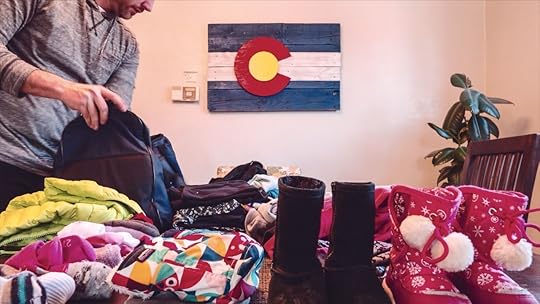
Photo: Brian Lewis
“For the past decade or so, yurt trips had been our thing,” Brian says, narrating a journal he is keeping for Kaiya. “Your mom and I had done a trip almost every year. These trips were always about getting away to the mountains in the middle of winter. About slowing down and watching clouds, and chopping wood, and quality time with quality humans. So as soon as you popped into the world, we knew that would be one of our first cold-weather expeditions.”
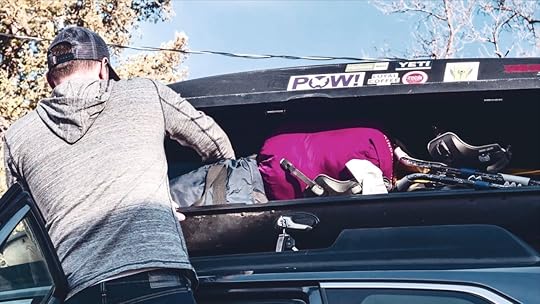
Photo: Brian Lewis
He soon realized, however, that a yurt trip with Kaiya would be totally unlike any trip they had taken before. “A trip with you always started with this simple fact,” he continues in the journal. “We were gonna need a lot of stuff. Even though you were half the size of a normal human, we were gonna need double the amount of things we’d take on a pre-kid outing.”
Indeed, Brian talks about making extensive packing lists including diapers, wipes, a pack-and-play, books, toys, and other items needed to care for a toddler on vacation.

Photo: Brian Lewis
“Packing was always a delicate dance between preparation and worry,” he says. “Worry led to staying home. Preparation led to moments of pure childhood perfection.”
The idea of traveling with a toddler may sound daunting, but Brian insists it’s all worth it. Even if you forget some “essential” supplies or that extra jar of food. In fact, Kaiya hardly ate the healthy food they’d packed, preferring instead a dinner of olives and hot chocolate.

Photo: Brian Lewis
Seeing Kaia’s delight on discovering newly fallen snow one morning was enough to make the effort worthwhile. And then there was the arrival of New Year’s Eve itself.
“When the sun turned to fire,” he says, “and the full moon lit the snowy peaks, and the Champagne corks popped, it didn’t matter what we’d brought. It didn’t matter that she didn’t nap, and we never even used the pack-and-play we struggled to fit in the car… It only mattered that we were here, in the mountains, together.” 

More like this: How to raise a wild traveling toddler
The post Why you need to take that epic trip with your toddler appeared first on Matador Network.

JetBlue spring sale with $44 flights

Planning your summer PTO can quickly turn from exciting to daunting as you begin to consider your budgetary restrictions and try to narrow down possible dates. JetBlue is making that process a bit easier, offering one-way flights as low as $44, for travel dates between May 8 and June 20. Flights depart from most major US cities, even bringing you to tropical destinations like Puerto Rico and the Dominican Republic. Here are some of our favorite deals.
Long Beach to San Jose for $44
New York City to Bermuda for $94
Albany to Orlando for $99
Boston to Jacksonville for $84
Orlando to Mexico City for $99
The best part about this promotion is that it doesn’t just apply to flights, but there are also flights+hotel combo packages. For example, you can fly from Buffalo to Orlando and spend three nights, all for just $469. There’s also a Long Beach to Las Vegas package, perfect for a long weekend, at $149 for a two-night stay with flight included.
To take advantage of the sale, you must book before it ends on midnight on May 1 and be aware of blackout dates from May 23-28. So no, unfortunately, this promotion can’t feature in your Memorial Day plans. Check out the website for a full list of flights and packages. 
H/T: Apartment Therapy

More like this: 6 underrated spring break vacations you can actually afford
The post JetBlue’s spring sale with $44 flights ends at midnight appeared first on Matador Network.

Matador Network's Blog
- Matador Network's profile
- 6 followers



